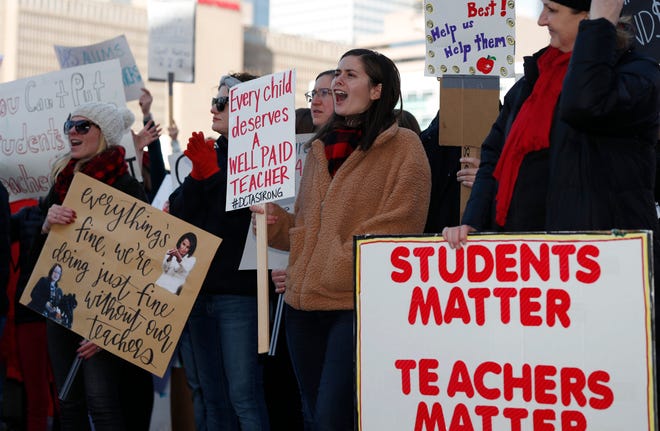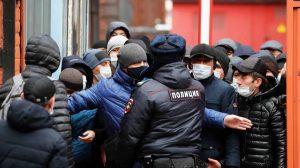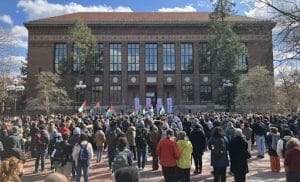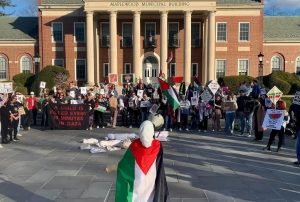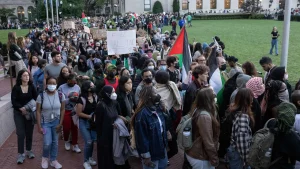Although I am a tenured teacher, I teach in a Right to Work state where I can be fired without cause and have my teaching license revoked. Because of this, I am not revealing any information that will make it easy to identify me or my district. I will simply say that I teach in a large high school in a somewhat large school district in Tennessee. The data cited here are from official public sources. Out of concern for my job and my license, I will not provide links to this information. Finally, I want to state that while I am deeply concerned for all the stakeholders impacted by my school district’s dangerous and irresponsible policies, I am writing this account from the point of view of a worker. Teachers have little recourse to the policies in our districts and state. Not only do we lack union representation, but teachers are shamed both within the profession and the community when we self-advocate for reasonable pay and working conditions. We are at the mercy of public opinion in a state that has just cut funding for public schools while fully funding charter schools. If we make any attempt to advocate for our safety and the safety of our families and students, we are vilified as selfish and undeserving both by our colleagues and our communities. In this moment when others are making life and death decisions for us, I believe it’s important to speak out for those of us heading to the front lines without adequate protection.
On Wednesday, under federal pressure from Secretary of Education Betsy DeVos and the corporate interests she serves, my district revealed its plan to reopen schools in mid-August. Students and teachers will report to schools with minimal safety guidelines in place, few of which reflect previous CDC recommendations for school reopening. New CDC recommendations for schools are being blocked by the White House. District leaders assure us that all voices have been heard in an open process during the planning and decision making, but neither I nor many of my fellow teachers have had any say in how and when we go back to work.
The reopening plan was developed, not with teachers, but by a task force of community stakeholders recommended by the school board. Each school board member recommended one person for the task force. The task force includes: one church leader, one university professor, two parents, three business owners, and a school administrator. There were no teachers, nor teacher representatives, on the task force that would determine how we would resume instruction in the classroom.
The task force plan is based on the results of a survey sent out to school stakeholders in the district: parents, students, teachers, administrators. Meetings with stakeholder focus groups were also cited as the basis for the district’s policy decisions. At the time the survey was sent out on June 1, there were just seven new cases of Covid19 in our district. The next day, June 2, new cases jumped to twenty-three. The data from the survey was released on June 23. New Covid cases on that day were thirty-six. The district’s plan was released to the public on July 15 when there were sixty-eight new casest. Today, two days later, new cases jumped to 147.
When presenting their recommendations and the return to school plan, task force and district leaders emphasized their reliance on this survey data as the basis for their decisions on how instruction will look in August. These leaders did not seem to take into account that the survey data and the plan do not reflect the current Covid19 surge in the southeast portion of the United States. During a subsequent school-wide meeting, administrators did not seem to register that there had been a 95% increase in Covid cases since the survey was disseminated on June 1. The school environment is exponentially more dangerous now than in March when we left school due to the pandemic.
The task force also based its recommendations for the return to school on meetings with focus groups of parents, teachers, and students. Rank and file teachers do not know which teachers were in those focus groups, how they were chosen, or what was discussed. Yet based on this input, our district feels confident that teacher voices have been heard.
At the same time as the task force was developing its recommendations for reopening schools, our local National Education Association (NEA) affiliate was in the midst of renegotiating our Memorandum of Understanding (MOU) with the district. Because we are a Right to Work state, teachers do not have a contract. An MOU delineates our pay and job responsibilities and provides some recourse in cases of grievous mistreatment or negligence by the administration for those teachers who pay dues to the TEA affiliate. In the last four months, while cases of Covid-19 were on the rise in our state, there was no communication to rank and file that the MOU this process was taking place this summer. The MOU was signed by teacher representatives on Tuesday, July 14, the night before the district’s reopening plan was unveiled, without any acknowledgement that teachers would be risking their lives by returning to work less than a month later. Rank and file members were not notified at any point that the MOU was up for renewal this summer, nor was there indication the MOU would be codified the night before the task force’s negligent and irresponsible back-to-school plan was released.
In other words, Tennessee teachers are having to return to their jobs based on subjective, qualitative survey data without authentic representation or voice in the decision to risk our lives under an MOU based on pre-pandemic working conditions.
Among the many vague and conflicting policies in the district’s reopening plan is how they will decide to open and close schools as the pandemic surges and wanes. They have developed a “stop light” system: red means distance learning, yellow means in person school with “safety” precautions, green means everything is normal. These indicators are typically based on some type of objective data, for example from local health departments or the CDC. However, contrary to the desires of the stakeholders who were surveyed in June, the district appointed itself to make the decision on whether we are in a red, yellow, or green moment, not the medical community. The district will not release the metrics they will use to determine red, yellow, or green conditions for schools, nor is it clear who in the district will make the decision. There is already a significant disconnect between what the community has decided is safe and what the school district has decided is safe. For instance, local churches are in red mode while schools are in yellow mode.
Parents have the choice to opt out of in-person school for their children, while teachers must report to school regardless of whether we are teaching virtually or in person. But with businesses and workplaces reopening around the country, many parents unable to stay home or afford childcare have no choice but to send their children back to school. Out of 70,000 students in our district, 11,000 have opted for distance learning. What this looks like for me is that 1,600 teenagers will be returning to poorly ventilated and over-crowded hallways and classrooms during a surge in new Covid cases in our county. My average class size is 35 teenagers. I teach three classes a day, five days a week.
At the school level, masks will be required, but teachers will not be provided PPE such as gloves, masks, or face shields for either ourselves or our students. Rather than giving us a supply of masks to hand out to students when required, we were told that we would have to rely on the “personal responsibility” of our teen-aged students to wash their masks everyday. This also presents an equity issue for students who may not have the access to resources to ensure mask hygiene. Likewise, although classrooms will be equipped with a “hand sanitizing station” and teachers will receive a spray cleaner to clean the classroom in the ten minutes between classes, paper towels will not be provided. We are instead encouraged to ask parents for paper towels, even as many may not have the extra income to provide these for their child’s classrooms.
Although the research now shows that Covid-19 is airborne and can be spread by asymptomatic carriers, daily temperature checks of staff and students will be required while no meaningful social distancing policies have been put in place. In other words, we will take some safety precautions, but they will not prevent the spread of the virus.
Class changes seem not to be part of any safety plan, either. It is impossible to avoid physical contact with others — let alone maintain a 6-foot distance — when 1,600 students will fill the hallways of my school and shuffle to their next class shoulder to shoulder, belly to backpack. It can take close to five minutes to exit a hallway into the main thoroughfare of our school where even more students are funneled as they make their way to their next destination. This happens four times a day. Additionally, students will eat lunch together in the cafeteria, which at my school means that three groups of 530 students will gather indoors and remove their masks to eat. Knowing that we will have super-spreader situations such as class changes, choir practice, lunch time, and other instances when groups of people are talking in a confined space, it is difficult to understand this oversight in the district’s recommended “safety precautions”.
No new substitute teachers were hired by the district this year. The majority of our substitutes are retired teachers who fall within a high risk category. There is already a substitute teacher shortage in the district, so the problem will be exacerbated by substitutes not returning to their jobs due to concerns about exposure to Covid-19. What this means for teachers who are not sick is that, in addition to the 100 or so students we can expect to be exposed to every day in our own classes, we will also be relied upon to cover the classes of absent colleagues when no substitute is available.
Fortunately, the community appears to be rallying against the district leadership’s plan for returning to school. A spontaneous letter-writing campaign targeting district leaders, state representatives, as well as the governor and our congress members has started on Facebook to decry the lack of science and transparency informing the school reopening plan. Community members are calling on teachers to strike, which is magical thinking in light of the Right to Work law, but represents an unprecedented shift in support of teachers against their bosses.
Teachers are also organizing in groups outside of our approved and ineffective NEA affiliate in response to our unsafe working conditions as well as the additional burdens of providing online instruction and the infringements on our plan time and lunches as we are called upon to cover for sick colleagues. These groups are still coalescing, and it remains to be seen whether teachers will overcome their fear of retaliation to stand together to challenge the absurdity of the district’s plan to return to school during a deadly pandemic with the strongest tools at their disposal.
We need to think creatively and act boldly to reverse the absurd mandate for anyone to return to school in person. Teachers should not be solely responsible for finding a solution to the life or death dilemma of educating students, especially since we don’t even have the basic right to organize for our interests. Fighting for our safety and that of our students, families, and communities requires broad action across all sectors affected by the reopening of schools in the middle of the pandemic. Community stakeholders must join educators to provide safe spaces for students to continue their education via distance learning. Employers must provide space within the workplace so employees’ children can participate in distance learning. Internet service needs to become a public utility and guaranteed to all households regardless of ability to pay. Further, we need a guaranteed monthly quarantine wage for teachers and parents who cannot bring their children to work to stay home with their children for as long as it takes to make sure students, teachers, and staff can go back to school safely. Community spaces such as churches must open their doors to provide supervised spaces for students to continue learning.
But in order to achieve any of these emergency actions, we need to use our strategic position as essential workers to force the hand of a government and education system that puts profits over our safety. Now, more than ever, we need all stakeholders to take responsibility for the education and welfare of our students in the form of collective action.


